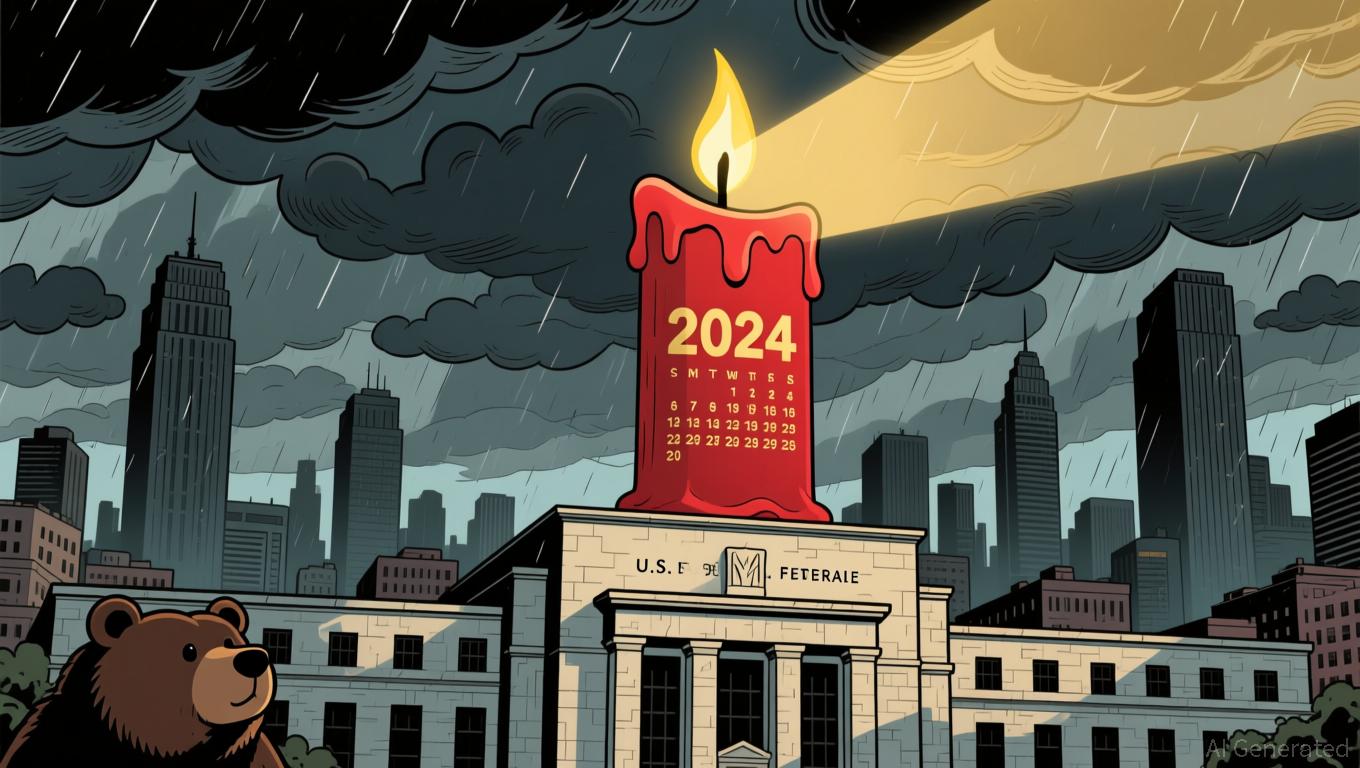Fragile Balance: Powell's Unpredictable Policies Rattle the Cryptocurrency Markets
- Fed Chair Powell's Jackson Hole speech triggered a $300B crypto sell-off as Bitcoin and Ethereum dropped amid inflation and policy uncertainty concerns. - Powell emphasized a "neutral" stance with cautious rate cuts through Q4 2025, highlighting fragile balance between inflation risks and slowing labor markets. - Market volatility intensified as traders priced in potential Trump-backed Fed leadership changes and data-dependent liquidity shifts in 2026. - Crypto's dual role as inflation hedge and speculat
On August 24, 2025, Federal Reserve Chair Jerome Powell’s address at the Jackson Hole Economic Policy Symposium led to a $300 billion drop in the global cryptocurrency market. Both
The market’s response was swift and pronounced. Bitcoin slipped 1.4% to $111,401, while Ethereum declined 4.2% to $4,006.79 [ 2 ]. This sell-off underscored how sensitive cryptocurrencies are to macroeconomic developments, especially after Powell cautioned that inflation remains “high” even with recent signs of easing. Market analysts observed that the Fed’s reluctance to signal a rapid easing cycle left investors facing greater uncertainty, particularly as the U.S. Treasury yield curve flattened and liquidity conditions stayed dependent on economic data [ 1 ].
Powell’s comments also introduced new uncertainty for future policy: the possibility of a Trump-endorsed successor taking over in 2026. Although Powell’s current term ends in May 2026, political friction—including Trump’s public criticism of Fed officials—has fueled speculation about a potential shift toward more accommodative monetary policy. However, such a change would depend on Senate approval and the broader economic outlook [ 1 ]. For now, the Fed’s commitment to both price stability and full employment continues to guide its cautious stance, with Powell stressing that “we will not let a single jump in prices turn into a persistent inflation issue” [ 2 ].
The reaction in the crypto sector to Powell’s statements highlighted its dual character as both a hedge against inflation and a speculative investment. An extended period of higher interest rates tends to limit liquidity-driven investments in alternative coins and crypto stocks, while ongoing inflation above the 2% target supports interest in limited-supply assets like Bitcoin. Still, volatility in the market has increased as traders try to anticipate changes in leadership and evolving macroeconomic signals. For example, U.S. spot Bitcoin ETFs saw $241 million in new investments on September 24, reversing two days of outflows, while Ethereum ETFs continued to see $79.36 million in withdrawals [ 3 ].
Looking forward, the relationship between Powell’s remaining term and the political timeline will influence market trends. Should a Trump-nominated chair take over in 2026, rate cuts could accelerate, but the transition period is expected to bring heightened volatility as investors brace for policy shifts. At the same time, the Fed’s attention to inflation expectations—especially the risk of tariffs causing persistent price increases—suggests that crypto’s short-term performance will continue to hinge on indicators like PCE inflation and employment data [ 1 ].
Disclaimer: The content of this article solely reflects the author's opinion and does not represent the platform in any capacity. This article is not intended to serve as a reference for making investment decisions.
You may also like
ZEC Drops 10.26% Over 24 Hours as Market Fluctuates
- ZEC dropped 10.26% in 24 hours to $495.01, but rose 778.18% annually. - Short-term decline reflects market volatility, with investors split between entry points and caution. - Analysts link ZEC's swings to macroeconomic factors and speculative trading, not direct news. - Broader crypto trends and leverage-driven corrections may influence future stability.

Bitcoin Updates: Bitcoin Climbs Even as ETF Outflows Hit Record Highs and Hopes for Fed Rate Cuts Fade
- Bitcoin rebounds as markets price a 46% chance of a December Fed rate cut, down from 93.7% in October. - U.S. spot Bitcoin ETFs saw $523M in single-day outflows, with BlackRock's IBIT leading $2.1B in redemptions. - Technical indicators show a fourth "death cross" and declining liquidity amid unresolved macro risks. - Traders add $5.7M in short positions, reflecting broader caution as crypto faces regulatory and volatility challenges.

Ethereum News Update: With Major Ethereum Holders Pulling Back and Tron Showing Little Movement, LivLive and BlockchainFX Are Driving the Crypto Market's Revival
- LivLive’s presale surpassed $2.1M, driven by real-world engagement and AR missions, offering 100%-200% token bonuses to early investors. - BlockchainFX secured $11M in presale funding with an international trading license, using a deflationary model to boost long-term value. - Ethereum whales retreated, while Tron’s TVL dropped to $4.58B amid stagnation and regulatory scrutiny. - Crypto’s shift favors projects with utility and compliance, with LivLive and BlockchainFX leading the resurgence amid broader

Zcash Halving and Its Effects on the Crypto Market
- Zcash's November 2025 halving reduces block rewards by 50%, tightening supply and reinforcing its deflationary model akin to Bitcoin . - ZIP 1015's lockbox mechanism removes ~$337,000 daily liquidity, while ZEC's price surged 1,172% YTD amid privacy-driven demand and institutional adoption. - Institutional investments like Grayscale Zcash Trust and 5% supply acquisitions highlight growing acceptance as a strategic reserve asset. - Privacy-focused adoption (28% shielded transactions) and negative Bitcoin